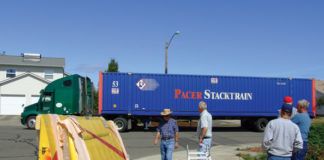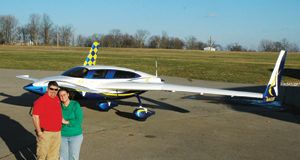To safely execute a flight, it is vital that the pilot be able to maintain control of the airplane all of the time. For the flight to be enjoyable, maintaining control should be easy.
Each phase of a flight places different demands on the pilot and requires a different level of pilot action and attention. The task load imposed on the pilot varies dramatically in different parts of a flight, and it is also significantly affected by circumstances such as weather or distractions in the cabin. Ideally, we want the pilot to be able to concentrate primarily on tasks other than maintaining control of the airplane. When we consider what constitutes good or even acceptable flying qualities, the level of pilot effort required to maintain control and execute the required task is the primary consideration.
Workload in the Cockpit
In addition to maintaining control of the airplane, the pilot must navigate, communicate, manage the airplanes systems (i.e. fuel management) and monitor the health of the engine. The total task load on the pilot depends on the situation. In level flight on a clear, calm VFR day, the workload is relatively low.
Even in a simple VFR flight, however, there are factors that increase workload significantly. Flying the traffic pattern tasks the pilot more heavily than cruising. In particular, the base-to-final turn is a relatively high-workload maneuver because the pilot must manage rate of descent and control the turn rate of the airplane so that the flight path lines up on the final approach heading when the airplane is over the extended centerline of the runway. Unlike cruise flight, where small deviations in height and heading need not be corrected rapidly, the base-to-final turn imposes tighter requirements on the flight path. The pilot is trying to hit a specific point in the sky (the top of the final approach path) at a specific airspeed. Accordingly, the lateral and vertical portion of the airplane must be managed as well as holding airspeed in a turning, descending maneuver. Not surprisingly, base-to-final turn is the most common point in a VFR flight where loss-of-control (stall/spin) accidents occur.
In IFR conditions, the pilot must devote considerable attention to navigating, setting radio frequencies and communicating with air-traffic control (ATC). Accordingly, less attention is available to control the attitude and airspeed of the airplane. If the conditions are turbulent, or if the pilot must divert and revise the flight path at the same time the workload gets even higher. This becomes dangerous when the workload gets so high that the pilot cannot properly perform all of the tasks required to safely conduct the flight. If the task that gets overwhelmed by workload is retaining control of the airplane, the results can be catastrophic.
In these high-workload situations, it is important that the airplane be well behaved so that it will maintain a safe flight condition even when the pilots attention is diverted. Both stability and trim characteristics of the airplane can be important.
Trim
A trimmed airplane requires no pressure on any of the flight controls. If the pilot releases the controls, the airplane will not immediately pitch, roll or yaw. Most airplanes have some long period, gradually developing modes that cause the flight path to diverge eventually, but if they are initially in trim these take many seconds to develop. If the airplane is in trim, the pilot can be briefly diverted from paying attention to the attitude of the airplane and, provided that the controls are not moved inadvertently, the airplanes attitude and flight path will not change.
If the airplane cannot be trimmed, the situation gets more difficult. To keep an out-of-trim airplane in a stable flight condition, the pilot must exert a steady pressure on the controls. Even under benign conditions this is tiring and unpleasant. When the workload increases, it can become a serious problem. The pilot must maintain the steady control pressure while simultaneously reading a chart, adjusting a radio or communicating with ATC. If the other tasks absorb too much concentration, it is likely that the pilot will relax, or sometimes increase the control pressure held to keep the airplane in trim.
When this happens the airplane will diverge, and roll or pitch. The pilot must take attention away from other tasks to regain control of the airplane. If the pilot does not pay sufficient attention to the attitude of the airplane, a large roll or pitch excursion might occur, and the uncommanded deviations may be dangerous. The pilot may lose control of the airplane or cause damage to it by making a sudden control input.
Even if this does not happen, the pilot is forced to juggle controlling the airplane and performing the other tasks, and will be working much harder to do what needs to be done than if the airplane were in trim. Even if the pilot is free to concentrate on flying the airplane, being out of trim can increase workload. The control inputs required to perform a maneuver change can degrade the pilots ability to hold proper airspeed or attitude.
Being out of trim is not always bad. The Blue Angels demonstration teams F-18s have a spring that pulls the stick forward so that the pilot must continually pull on the stick to maintain trim. This is to keep the pilot from having to transition back and forth from pushing to pulling on the stick while flying the tight formations for which the team is famous. The pilots found that it was difficult to make small corrections while feeling small push or pull forces through their gloves. By deliberately mis-trimming their airplanes nose down, they are always pulling hard enough to get good force feel feedback.
Stability
The stability of the airplane can also have a dramatic effect on the pilots workload. Under ideal conditions, a pilot can maintain control of an airplane that is neutrally stable, or even slightly unstable in pitch and yaw. To do so requires constant attention and control inputs, but it is possible. If the airplanes stability is low, the pilots attention must be devoted to maintaining the desired flight condition. If the pilots attention is diverted, the airplane will tend to pitch or yaw and can end up in an unpleasant flight condition.
This situation gets worse in turbulence. If the airplane is only marginally stable, turbulence will cause relatively large deviations from the desired flight path. At the same time, a marginally stable airplane will react quickly to a relatively small control input. The pilot must compensate for large turbulence-induced motions with small control inputs. If the compensating inputs are too large, the pilot will produce just as much perturbation to the airplane as the turbulence. This effect is common on airplanes with vertical tails that are too small to produce strong yaw stability.
Historical Precedent
This characteristic of poor yaw stability was an ill of pre-WW-II airplanes, and unfortunately of homebuilts designed to go fast. If the airplane is soft directionally, gusts cause uncomfortable yaw excursions or Dutch Roll oscillations that the occupants describe as a “tail wag.” The pilot may have a hard time damping the tail wagging with rudder because of the low weathercock stability of the airplane. Rarely dangerous, it makes the ride uncomfortable.
Poor pitch stability can be more dangerous. An airplane that is deficient in pitch stability requires considerable pilot attention to maintain airspeed and load factor. Under high workload conditions, it is easy for the pilots control of airspeed to degrade, leading to overspeed incidents in up-and-away flight and inadvertent stall in maneuvering flight.
An airplane with insufficient longitudinal stability may also overstress at high speed because the marginal pitch stability causes the stick force per G to be low, which means the pilot can load up the airplane with a small pull on the stick. An abrupt stick input, either to initiate a maneuver or recover from an upset, can overstress the airframe.
The proper level of pitch stability is a difficult compromise for the designer. There are several factors that tend to drive the design to be less stable. The first is drag. Airplanes have less drag when they are flying with the cg aft because this reduces the trimming download the tail must produce. To get the last bit of performance out of an airframe, there is a temptation to pull the cg as far aft as possible without making the airplane dangerous or unpleasant to fly. The reduced tail download also reduces stall speed slightly, so, paradoxically, an aft cg reduces stall speed but makes the airplane easier to inadvertently stall.
Maneuverability is also improved by reducing stability. A stable airplane resists attempts to change its flight path. The less stable it is, the easier it is to maneuver. Reducing pitch stability makes the airplane more maneuverable, and this is probably why some manufacturers and builders claim to like airplanes with marginal pitch stability. Modern fighters take this to extremes. They are deliberately made unstable in pitch, and use a high-speed flight control computer to control the elevators and keep the airplane under control. The pilots stick commands a desired G load or angle of attack to the computer, and the computer flies the airplane. A human pilot, without the aid of a computer, cannot keep a significantly unstable airplane under control for long.
For aerobatic airplanes, and for racers or competition sailplanes where every bit of performance is important, we might accept a level of pitch stability that requires more than ideal levels of pilot attention. However, for any airplane that is primarily flown in cruise, a higher level of pitch stability is highly desirable, and will make the airplane both safer and more pleasant to fly.













